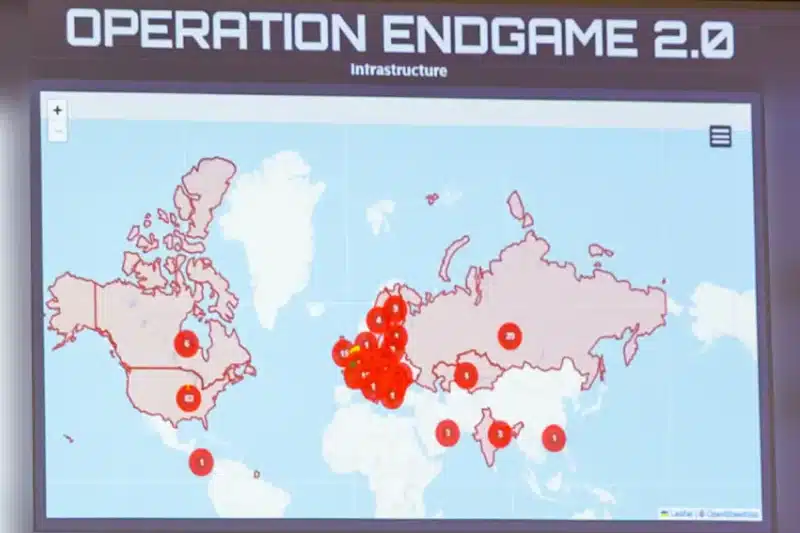
A coordinated cyber takedown executed by international law enforcement this week has hit the ransomware economy where it hurts most—its infrastructure. Dubbed Operation Endgame 2.0, the sweeping effort saw over 300 servers dismantled, 650 domains neutralized, and 20 suspected cybercriminals slapped with international arrest warrants.
It’s a follow-up to 2024’s record-setting botnet crackdown, but this time with a sharper aim: kill the attack chain before ransomware even loads. And it’s working.
Also read: Operation Endgame – Largest Ever Operation Against Multiple Botnets Used to Deliver Ransomware
From May 19 to 22, agencies across seven countries, including the U.S., U.K., Germany, France, the Netherlands, Canada, and Denmark, worked under the coordination of Europol and Eurojust to go after what cybersecurity pros call initial access malware—the first-stage droppers that sneak into systems, open the back door, and pave the way for full-scale ransomware deployment.
In short, Operation Endgame 2.0 just made life a lot harder for ransomware crews.
From Bumblebee to Trickbot, the Droppers Are Dropping
On the hit list were some of the nastiest names in malware-as-a-service: Bumblebee, Qakbot, DanaBot, WarmCookie, Lactrodectus, Trickbot, and HijackLoader. These aren’t flashy strains that encrypt your files and demand crypto. Instead, they’re stealthy loaders—used by ransomware gangs to gain access, establish footholds, and hand off victims to affiliates for the final payload.
By pulling the plug on these services, law enforcement didn’t just nab some servers. They disrupted a billion-dollar cybercrime ecosystem.
“This new phase demonstrates law enforcement’s ability to adapt and strike again, even as cybercriminals retool and reorganize,” said Europol Executive Director Catherine De Bolle in a statement.
“By disrupting the services criminals rely on to deploy ransomware, we are breaking the kill chain at its source.”
Follow the Money—and the Servers
The takedown wasn’t just about digital infrastructure. Investigators seized over €3.5 million in cryptocurrency during the operation, pushing the total crypto haul from the two Endgame operations north of €21 million. That kind of financial disruption hits threat actors right in their incentive structure.
Meanwhile, over 300 servers and hosting services across dozens of countries went offline, thanks to simultaneous seizures and shutdowns coordinated through Europol’s cybercrime task force. The operation was so complex that Europol set up a real-time Command Post in The Hague, where agents from across North America and Europe directed the digital sting like a cyber version of Interpol meets Ocean’s Eleven.
Cybercrime’s Most Wanted
Authorities aren’t done yet. Germany has placed 18 of the suspects involved on the EU’s Most Wanted list. These aren’t low-level scammers. Many of the individuals targeted are believed to be the architects of infrastructure used to deploy ransomware globally—providing access-as-a-service to criminal gangs responsible for attacks on hospitals, city governments, and major corporations.
The announcement also suggests more arrests could follow, with investigations still unfolding and infrastructure leads being analyzed. Operation Endgame 2.0, in name and nature, seems far from over.
Why This Matters Now
Ransomware has dominated the cybersecurity conversation for years, evolving from isolated extortion attempts into a full-blown criminal industry backed by scalable infrastructure and professional-grade support services. In fact, a Y-o-Y comparison from cybersecurity company Cyble’s latest Ransomware Threat Landscape report showed that ransomware attacks have jumped by 86% in this year’s first four months alone. And no points for guessing, the United States remained the most targeted country around the globe with nearly 1400 attacks.

Much of that industry depends on initial access brokers—shadowy groups that specialize in getting into systems, then selling or renting out that access to ransomware gangs like LockBit, BlackCat, or Royal.
By targeting these brokers and the malware they use, Endgame strikes at the root of modern ransomware. It’s the cyber equivalent of cutting off supply lines before enemy forces even get to the battlefield.
And with droppers like Qakbot and Trickbot re-emerging even after previous takedowns, the new wave of arrests and infrastructure seizures sends a clear message: rebuild if you dare, but we’re watching.
What Comes Next
The Europol-led coalition isn’t just celebrating its wins. It’s looking ahead. When the agency releases its next Internet Organised Crime Threat Assessment (IOCTA) on June 11, the spotlight will be firmly on initial access brokers. That’s a strategic shift from whack-a-mole takedowns to long-term disruption of how cybercriminals do business.
Operation Endgame 2.0 also marks another turning point in cross-border cyber policing. With adversaries operating globally, the defenders are finally catching up. The seamless cooperation between countries, rapid sharing of intelligence, and simultaneous global enforcement may just be the new normal for tackling cybercrime.
So, while the ransomware threat isn’t gone—and probably won’t be anytime soon—its digital supply chain just took a serious hit. And this time, the message wasn’t just “We see you.” It was: “We’re coming for the foundation you built.”
Source: Read More
